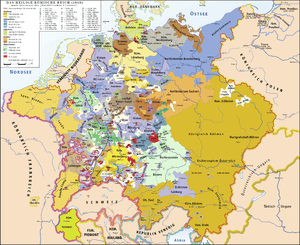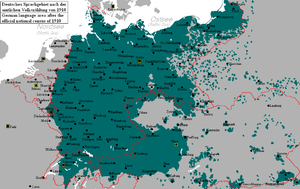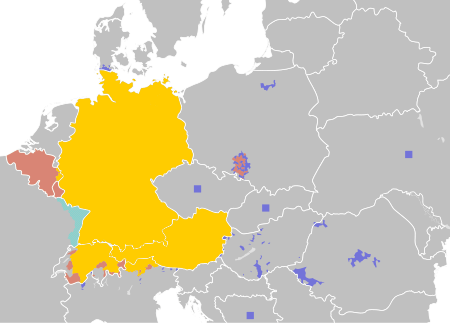New High German
New High German (NHG) is the term used for the most recent period in the history of the German language, starting in the 17th century. It is a translation of the German Neuhochdeutsch (Nhd). The most important characteristic of the period is the development of a standard written German, followed by the standardisation of the spoken language.[2] For this reason, the term New High German is also used as a synonym for modern Standard German.
| New High German | |
|---|---|
| Neuhochdeutsch | |
| Native to | Germany, Austria, Luxembourg, Liechtenstein, Switzerland, Netherlands, |
Indo-European
| |
Early forms | |
| German alphabet | |
| Official status | |
Official language in | Austria, Germany, Liechtenstein, Luxembourg, Switzerland, Belgium; European Union; Namibia until 1990. |
| Language codes | |
| ISO 639-1 | de |
| ISO 639-2 | ger (B) deu (T) |
| ISO 639-3 | deu |
| Glottolog | mode1258[1] |
Periodisation
The German term was originally coined in 1819 by Jacob Grimm for the period from around 1450 to the present day, following on from Middle High German (Mittelhochdeutsch).[3][4] However, in 1878 Wilhelm Scherer proposed a transitional period, 1350–1650, for which he coined the new term Frühneuhochdeutsch (Early New High German), thus dating New High German from the mid 17th century.[5] In spite of many alternative proposals,[6] Scherer's remains the most widely adopted periodisation of German.[7]


There are both linguistic and extra-linguistic reasons for regarding the mid-17th century as the beginning of a new linguistic period. By this time, the sound changes which result in the phonological system of Modern German had been completed - no further major changes take place within the NHG period.[8] The Thirty Years War saw the population reduced by at least one third, and the subsequent Treaty of Westphalia, signed in 1648, guaranteed the relative independence of hundreds of small and large states within the Holy Roman Empire, as well as recognizing the complete independence of the Netherlands and Switzerland.[9] The 1641 publication of Justus Georg Schottelius's Teutsche Sprachkunst marks the beginning of the debate about a standardised national language.[10]
The New High German period is often subdivided, with a general consensus over a break in the first half of the 19th century, with another after 1945.[11] The earliest of these periods (Älteres Neuhochdeutsch) sees the gradual establishment of a standard written language by grammarians, lexicographers and writers; the second (Jüngeres Neuhochdeutsch) sees the spread of this standard throughout the publishing media (and becoming an international language of science), into the schoolroom, and into spoken German.[12] After 1945, the loss of German-speaking territory in the East, the decline of German as an international language, and the massive influence of English on the vocabulary are seen as markers of a new period, referred to as Gegenwartsdeutsch ("contemporary German").[13][14] These changes, however, are in the status and use of the language, while the phonology and morphology have seen only rationalisation and not substantial change over the last 370 years.[15][8]
Territory

For the first two hundred years of the period, the linguistic boundary of German remained relatively stable, even where the territory itself changed hands, as in Alsace, a French possession since the Treaty of Westphalia.[16] The only major area of change was in the East. Initially only individual German-speaking settlers moved into the underpopulated lands of Brandenburg, Pomerania and Bohemia, but in the late 17th century both Prussia and Austria had policies of attracting settlers to these lands.[17]
From the late 19th century, however, there have been significant losses of German-speaking territory. The eastward settlement of the earlier period was reversed by a Russian government policy of Russianisation and by the resistance of the Polish population to further German immigration, causing many German speakers to return West.[18] At the end of the Second World War the German-speaking populations of Bohemia and the land east of the Oder-Neisse line, which became part of Poland, were forcibly expelled.[19]
Characteristics
The New High German period is characterised by the codification of German grammar and the development of a standard language in both writing and speech. Unlike earlier periods, there have been few major changes in phonology or morphology. Rather, the standard language has selected particular features and these choices have then exerted an influence on individual German dialects.[2]
See also
- German literature of the Baroque period
References
- Hammarström, Harald; Forkel, Robert; Haspelmath, Martin, eds. (2017). "Modern High German". Glottolog 3.0. Jena, Germany: Max Planck Institute for the Science of Human History.
- Besch & Wolf 2009, p. 227.
- Grimm 1819, p. xxvi.
- Grimm & Grimm 1854–1863.
- Scherer 1878, pp. 13–14.
- Roelcke 1998, with a table of the main alternative proposals.
- Wells 1987, p. 23.
- Penzl 1975, p. 125.
- Keller 1978, p. 338.
- Rolf, Moulin & Ruge 2016, p. 20.
- Roelcke 1998, pp. 804–811.
- Sonderegger 1979, pp. 183–184.
- Young & Gloning 2004, pp. 307–308.
- Roelcke 1998, pp. 804–813.
- Sonderegger 1979, p. 179.
- Keller 1978, p. 470.
- Keller 1978, pp. 479–481.
- Keller 1978, pp. 481–483.
- Keller 1978, pp. 482–483.
Sources
- Besch, Werner; Wolf, Norbert Richard (2009). Geschichte der deutschen Sprache. Berlin: Erich Schmidt. ISBN 9783503098668.CS1 maint: ref=harv (link)
- Grimm, Jacob; Grimm, Wilhelm (1854–1863). "neuhochdeutsch". Deutsches Wörterbuch. Leipzig: Hirzel.CS1 maint: date format (link)
- Grimm, Jacob (1819). Deutsche Grammatik. Göttingen: Dieterische Buchhandlung.CS1 maint: ref=harv (link) Reprint
- Grimm, Jacob (1822). Deutsche Grammatik (2nd ed.). Göttingen: Dieterische Buchhandlung.CS1 maint: ref=harv (link)
- Keller, R.E. (1979). The German Language. London: Faber and Faber. ISBN 0-571-11159-9.CS1 maint: ref=harv (link)
- Penzl, Herbert (1975). Vom Urgermanischen zum Neuhochdeutschen : eine historische Phonologie. Grundlagen der Germanistik 16. Berlin: Erich Schmidt. ISBN 3-503-00790-3.CS1 maint: ref=harv (link)
- von Polenz, Peter (2000). Deutsche Sprachgeschichte vom Spätmittelalter bis zur Gegenwart. I: Einführung, Grundbegriffe, 14. bis 16. Jahrhundert (2nd ed.). De Gruyter. ISBN 978-3110164787.CS1 maint: ref=harv (link)
- von Polenz, Peter (1999). Deutsche Sprachgeschichte vom Spätmittelalter bis zur Gegenwart. II: 17. und 18. Jahrhundert (2nd ed.). De Gruyter. ISBN 978-3110143447.CS1 maint: ref=harv (link)
- von Polenz, Peter (2013). Deutsche Sprachgeschichte vom Spätmittelalter bis zur Gegenwart. III: 19. und 20. Jahrhundert (2nd ed.). De Gruyter. ISBN 978-3110314540.CS1 maint: ref=harv (link)
- Roelcke T (1998). "Die Periodisierung der deutschen Sprachgeschichte". In Besch W, Betten A, Reichmann O, Sonderegger S (eds.). Sprachgeschichte. 2.1 (2nd ed.). Berlin, New York: Walter De Gruyter. pp. 798–815. ISBN 3-11-011257-4.CS1 maint: ref=harv (link)
- Scherer, Wilhelm (1878). Zur Geschichte der deutschen Sprache (2nd ed.). Berlin: Weidmann.CS1 maint: ref=harv (link)
- Sonderegger, Stefan (1979). Grundzüge deutscher Sprachgeschichte. I. Berlin, New York: Walter de Gruyter. ISBN 3-11-003570-7.CS1 maint: ref=harv (link)
- Wells, C. J. (1987). German: A Linguistic History to 1945. Oxford University Press. ISBN 0-19-815809-2.CS1 maint: ref=harv (link)
- Young, Christopher; Gloning, Thomas (2004). A History of the German Language through texts. London, New York: Routledge. ISBN 0-415-18331-6.CS1 maint: ref=harv (link)